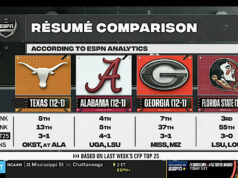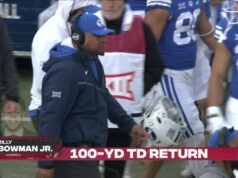
Oklahoma football fans, like me, are always disappointed when the team from our flagship state university loses to its Texas counterpart. Of course, we should be elated that Oklahoma can, on occasion, even be competitive.
The University of Texas trounces the University of Oklahoma so completely in things like academic research, Nobel Prize-winning faculty, and faculty members in the National Academy of Sciences that the two are not even in the same league. (The “league,” in this case, is the Association of American Universities — an “organization of leading research universities devoted to maintaining a strong system of academic research and education”.)
This is not really a fair comparison. The two states each have only one flagship university, and the economic activity of 27 million Texans should be able to support a flagship that the 3.8 million Oklahomans, hard working as we are, can’t match.
Given the difference in population sizes, it’s no surprise that Texas collectively overwhelms Oklahoma from an economic standpoint. Unfortunately, we also tend to measure up poorly in individual demographic measurements. Compared to Oklahomans, Texans are:
- younger (10.7 percent of the population over 65, compared to 13.5 percent);
- better educated (27.8 percent with bachelor’s degrees or higher, compared to 24.2 percent);
- slimmer (31.9 percent obese, compared to 33 percent);
- and richer (per capita income of $41,471, compared to $39,006; all data from US Census Bureau).
Oklahomans could always try to be competitive by working harder and earning more, losing some weight, and finishing up those college degrees (or starting on them). But that assumes we’re not all doing the best we can in those areas already. Besides, no amount of effort is going to make us any younger.
It is amusing to imagine the hapless Okie (obviously one of those lacking a bachelor’s degree) who learns that Texans are younger, thinner, smarter and richer, and so decides to relocate to Texas, thereby automatically becoming younger, thinner, smarter and richer himself.
But suppose we all did. Consider the following thought experiment:
Move the Oklahoma border from the Red River to the Kansas line, and combine the two populations into one. In the combined state,
- the per capita income would be $41,165.41 (a gain of $2,159.41 for the former Oklahomans);
- only 32.04 percent of the combined population would be obese (a drop of 0.96 percent for the former Oklahomans);
- 27.35 percent of the combined population would be college educated (a gain of 3.15 percent for the former Oklahomans);
- and only 11.05 percent of the combined populations would be over 65 (a drop of 2.45 percent for the former Oklahomans).
Magically, the average Oklahoman becomes richer, thinner, better educated and younger, without having to move, work harder, diet or study.
But what about those poor Texans who would see their per capita income drop by $493.65?
I promise, no Texans are going to be hurt in our thought experiment. We are simply talking averages here; no actual former Texan would see any change in what they make, or how old they are, or how much college they have had, or how fat they are. Nor would any actual former Oklahoman.
One group of Oklahomans seriously considering relocation to Texas are the Oklahoma teachers, who earn an average salary of $44,128 compared to the average Texas teacher salary of $48,110. If we combine the populations of Oklahoma teachers and Texas teachers for statistical purposes and compute the average salary, we get $47,616.35, an increase of $3,888.35 for the Oklahoman teachers. Not only is this insufficient (each Oklahoma teacher needs a $5,000 raise), it is illusory. What we need are not increases in the average but increases for individuals.
This thought experiment is actually an exercise in understanding the limits of using averages as a summary measure of population characteristics. Consider the income component of our thought experiment: No additional income was earned by anyone in either state. But even if additional income is earned by a fraction of the population, and the average income thereby increases, the amount earned by each earner in the remainder stays the same.
For example, if the income of the top 1 percent of earners goes up 10 percent, the average income increases substantially, even though none of the bottom 99 percent sees any change in what they earn.
This is only a slight caricature of what has happened in the United States since the Great Recession of 2009, but it explains why many workers feel the recession has lasted until today. It also explains why other summary measures of central tendency, like the median, are often used to explain population data, but exploration of that must await a future column.





















